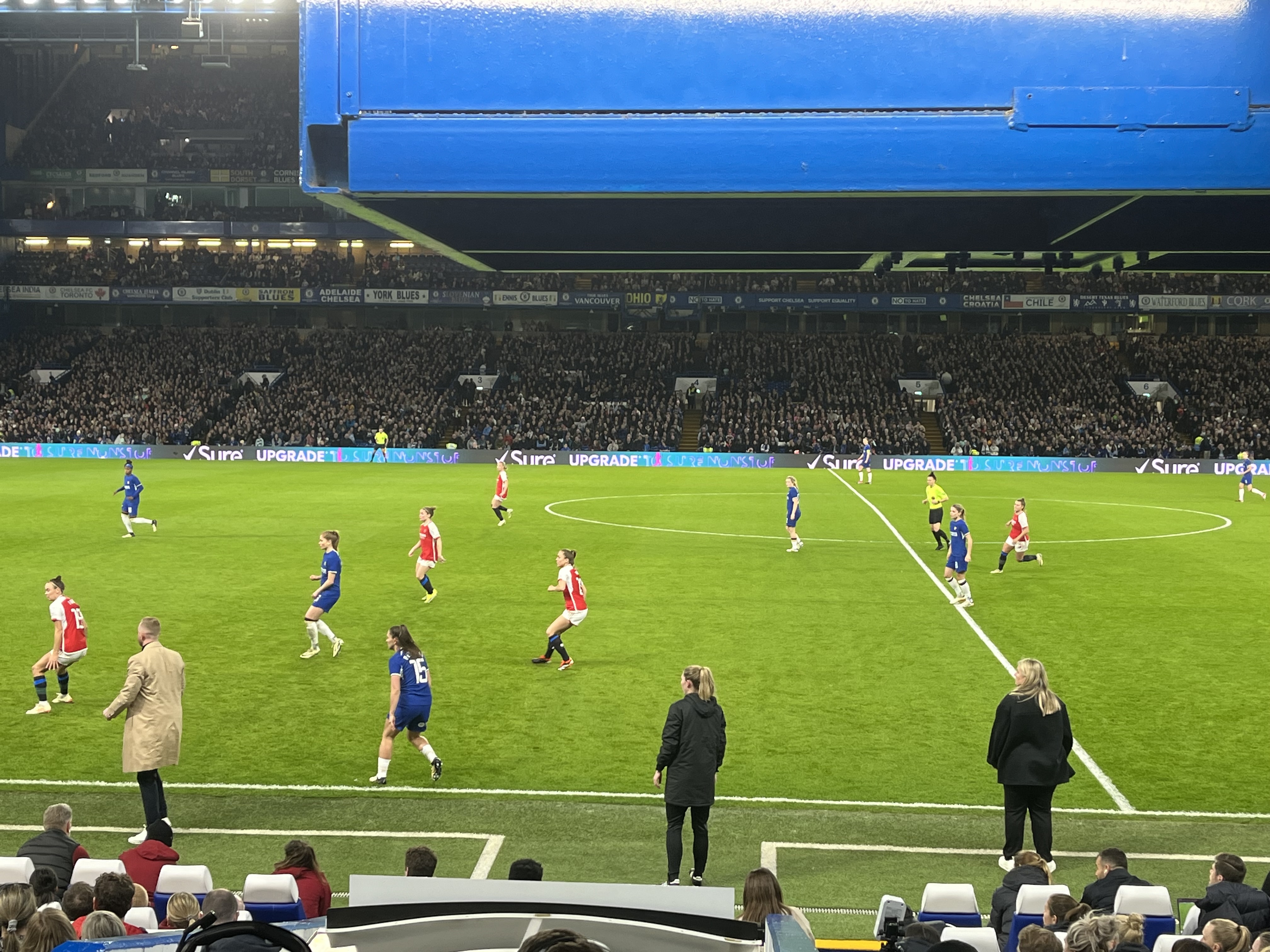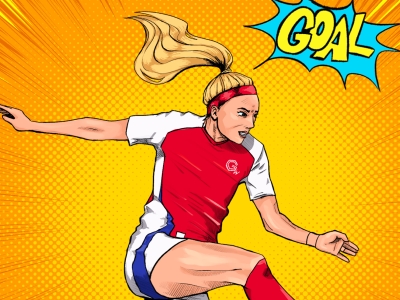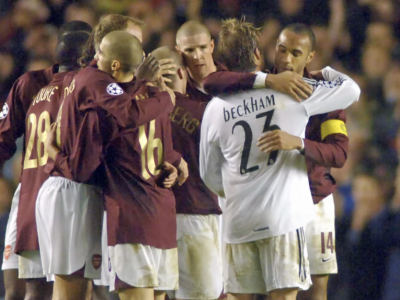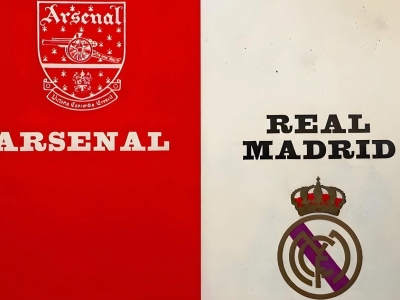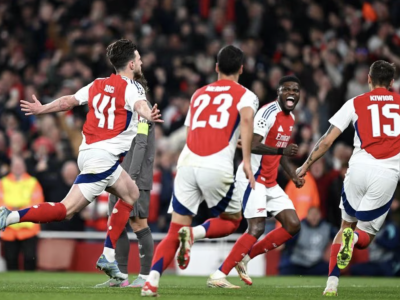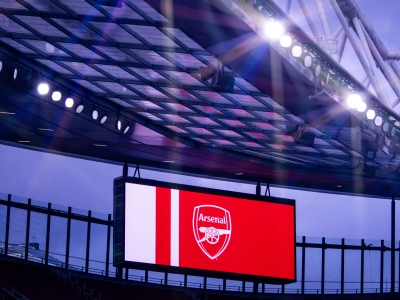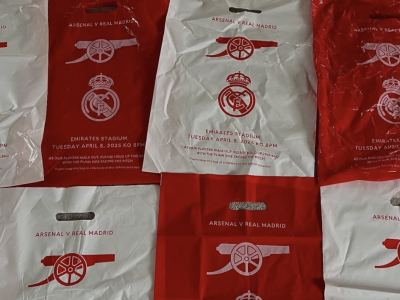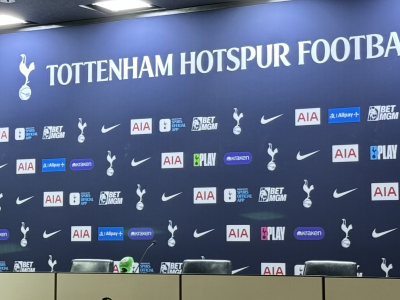Introduction:
Arsenal Women’s success in the ‘bigger’ games this season has not gone unnoticed, and has been the subject of discussion when looking at how the team have played tactically and analytically.
Going into this game, especially after a dominant 4-1 victory earlier in the season, many would have predicted Arsenal to put up a fight throughout and for this to be an extremely close encounter.
A victory would have seen Arsenal move level on points with Chelsea, yet a win for Chelsea would see them widen the gap to six points.
It is important to consider that even before the match began, complications arose. The game was postponed for half an hour due to a ‘kit clash’ that saw Arsenal forced to wear Chelsea socks, and this is something that likely had a psychological effect, especially considering how hugely important the game was.
Lineups:
Chelsea (4-2-3-1) Hampton; Charles, Buchanan, Carter, Perisset; Leupolz, Cuthbert; Reiten, Nusken, Kaneryd; James.
Arsenal (4-2-3-1) Zinsberger; Catley, Wubben-Moy, Williamson, McCabe; Walti, Pelova; Foord, Little, Mead; Blackstenius.
Arsenal in possession/Chelsea out of possession:
In possession, when building up from the back, the two centre-backs for Arsenal split, with Manu Zinsberger higher up to offer support. In some instances, Lia Walti joined in the left-back position to help build up play, allowing Steph Catley and Katie McCabe to be positioned much higher up the pitch.
Beth Mead was moving infield between the lines to receive long or through balls to feet. She would then look for McCabe out wide, yet the pass was often over or under hit.
Stina Blackstenius was picked to start upfront for Arsenal, and a clear strength of her play is making runs in behind the backline to catch the opposition out. Although Blackstenius was attempting to make these runs in behind, Arsenal were choosing not to make these passes, often playing into midfield and losing the ball instead. This meant Blackstenius struggled to create any attacking opportunities or play a part in the game.
Playing Williamson also typically benefits Arsenal in attack, as she is extremely effective at playing passes through the lines to break the opposition press. She struggled to do this throughout this match, however, with Chelsea able to intercept.
Out of possession, Lauren James and Sjoeke Nusken were positioned furthest forward for Chelsea, blocking the passing routes to Victoria Pelova and Lia Walti. Erin Cuthbert blocked the passing route to Kim Little. James would look to press Williamson when she received the ball, often forcing her backwards or into rushed, long balls that Chelsea would either clear or win.
The Chelsea press was extremely effective in closing off the Arsenal midfield, preventing them from receiving passes or having any time on the ball. When Chelsea closed off Pelova with three or four players, this did however open up space on the other flank. If Arsenal could move the ball fast enough they could create space and potential attacking opportunities, yet the pass was often inaccurate and allowed Chelsea to intercept.
When Arsenal moved the ball quickly, they could create attacking opportunities, yet this happened rarely throughout. One instance saw Lotte Wubben-Moy supporting Foord and Catley in the attack on the left side. When Chelsea were defending Foord and Catley, Wubben-Moy could utilise her long ball ability to switch it to Mead in space on the other flank, as the Chelsea backline were stretched.
This led to Mead pulling the ball back for Little, who got a shot away and forced Hannah Hampton into a save. This was also demonstrated at the start of the second half when substitute Alessia Russo utilised her hold up play and laid it off to Mead, who switched it quickly to McCabe on the other flank. She was able to get a shot away that went just over the crossbar.
Even when given great set piece opportunities, such as a free kick on the edge of the box, Mead placed her shot over the bar. This could have acted as an opportunity for Arsenal to get back into the game.
Chelsea were picking up all the loose balls, allowing them to regain possession and create more attacking opportunities. Chelsea were also doing their defensive work extremely well. They got numbers back to defend when Arsenal had a corner. Eve Perisset dealt extremely well with Foord, not allowing her to dribble past or excel as she typically does in one-v-one situations. Niamh Charles did the same with Mead on the other flank. Kaneryd was also getting back to defend, following Catley when she made the overlapping run to force her backwards or regain possession.
In the second half Arsenal were able to create more attacking opportunities, yet their only goal came from a well worked set piece that Chelsea failed to clear. Little was awarded space on the edge of the box and hit it first time. It deflected off Catarina Macario and won a late goal back for Arsenal.
Russo coming on benefitted Arsenal as she was able to drag defenders out of position and create space. This was something Arsenal failed to do in the first half, and perhaps they could have benefitted from Russo starting to utilise this strength. Many substitutions made a difference for Arsenal, raising the question of whether these players should have started the game.
The final decision cost Arsenal throughout the entire match, often shooting rather than playing the pass or over/under hitting passes.
Chelsea in possession/Arsenal out of possession:
Chelsea started the game extremely well, winning the loose balls and putting Arsenal under pressure. Within the first minute James even managed to get a shot away, forcing McCabe into a rushed clearance. Chelsea crowded out the Arsenal player on the ball with 2-3 players and retrieved the ball, laying it off to James at the edge of the box who got a shot away that went over the bar. Within the first two minutes of the game Chelsea had already managed to get two shots away.
In possession Chelsea opted for the same build-up play as Arsenal, with the two centre-backs in Kadeisha Buchanan and Carter splitting and Hampton supporting them.
The Arsenal press saw Blackstenius as the furthest forward for Arsenal, with Foord in-field trying to cover the pass through the middle. Little was unsure at times whether to mark Nusken (who was dropping deep to receive the ball), or mark Buchanan to try and force Chelsea back.
This opened up space for Hampton to play the ball to Nusken who found the space due to Little moving to press Buchanan on the ball. Nusken then looked for James, who dropped deep to provide a passing option.
Even when Arsenal tried to crowd out James with 4-5 players (the same as what Chelsea looked to do to Pelova), she managed to find Cuthbert who moved into space on the right. This space opened up when Foord was further up the pitch. With Wubben-Moy stepping out of position to follow James, Catley was forced to move across to CB to cover and space opened up for Johanna Rytting Kaneryd out wide.
Chelsea were having a lot of joy playing through the Arsenal team in this way throughout. It looked on a number of occasions like the Arsenal players were unsure who was responsible for marking who. This allowed runners for Chelsea, and happened mostly on the right side for Chelsea, with Foord, Catley and Walti responsible for man-marking.
Because of this, Chelsea were looking to catch Arsenal out of position and Arsenal did not adapt to deal with this. McCabe and Catley were both positioned high up the pitch, with Walti joining when Arsenal were on the attack. This meant if Chelsea were able to turn over possession Arsenal were left with just the two centre-backs isolated, with others not able to get back in time to defend. This allowed a lot of time and space on the ball for Chelsea’s wide players in Kaneryd and James when she moved out wide. This led to Kaneryd finding space for a shot that deflected off Nusken and into the bottom corner.
No Arsenal player got close enough to James, allowing her to run with the ball, dribble, switch the ball into space for runners and get shots away. Knowing how much of a threat James is for Chelsea, Arsenal needed to deal with this better.
Arsenal failed to mark Cuthbert on the edge of the box who had space to get a shot away that deflected off Nusken and snuck in past Zinsberger. The Arsenal backline were not in sync throughout the match, with Williamson just stepping out of line with the others, allowing Nusken to be onside for the goal.
Although rarely utilised in the first half, Chelsea looked to create attacking opportunities in the second half with balls in behind the backline, for James to run onto. Zinsberger did well to save in this instance, and in many others in the second half, to prevent a worse scoreline for Arsenal.
Closing Thoughts:
A significant amount of the discussion this season has been on how well Arsenal have performed in the ‘big’ games, especially following their 4-1 victory against Chelsea earlier in the season. Games of this magnitude are always detrimental to the title race, and with Chelsea now extending the gap between them and Arsenal to six points, this could be a key result when it comes down to the final day in the WSL.
For Arsenal going forward, their emphasis needs to be on winning every single game and worrying little about results outside of their control. The key issues that went wrong for Arsenal and allowed Chelsea to win this game included:
Team selection - the players who made an impact were those who came off the bench. Could the result have been different if these players started the game?
Defensive work - knowing who is responsible for marking who and knowing where to be and if need to cover other players
Moving the ball more quickly - this would allow Arsenal to catch Chelsea out in their defensive structure
Arsenal must work on correcting these issues (and others) extremely quickly and build on the positives that they have demonstrated in other games this season.
The main focus for Arsenal will need to be correcting these mistakes before the Continental Cup final against Chelsea if they are to be in with a chance of taking the trophy home.

